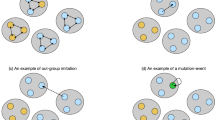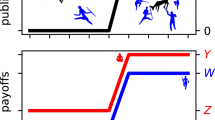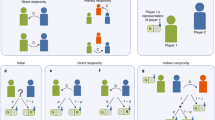Abstract
A long-standing problem in biological and social sciences is to understand the conditions required for the emergence and maintenance of cooperation in evolving populations. For many situations, kin selection1 is an adequate explanation, although kin-recognition may still be a problem. Explanations of cooperation between non-kin include continuing interactions that provide a shadow of the future (that is, the expectation of an ongoing relationship) that can sustain reciprocity2,3,4, possibly supported by mechanisms to bias interactions such as embedding the agents in a two-dimensional space4,5,6 or other context-preserving networks7. Another explanation, indirect reciprocity8, applies when benevolence to one agent increases the chance of receiving help from others. Here we use computer simulations to show that cooperation can arise when agents donate to others who are sufficiently similar to themselves in some arbitrary characteristic. Such a characteristic, or ‘tag’, can be a marking, display, or other observable trait. Tag-based donation can lead to the emergence of cooperation among agents who have only rudimentary ability to detect environmental signals and, unlike models of direct3,4 or indirect reciprocity9,10, no memory of past encounters is required.
This is a preview of subscription content, access via your institution
Access options
Subscribe to this journal
Receive 51 print issues and online access
$199.00 per year
only $3.90 per issue
Buy this article
- Purchase on Springer Link
- Instant access to full article PDF
Prices may be subject to local taxes which are calculated during checkout

Similar content being viewed by others
References
Hamilton, W. D. The genetical evolution of social behaviour, I and II. J. Theor. Biol. 7, 1–52 (1964).
Trivers, R. The evolution of reciprocal altruism. Q. Rev. Biol. 46, 35–57 (1971).
Axelrod, R. & Hamilton, W. D. The evolution of cooperation. Science 211, 1390–1396 (1981).
Axelrod, R. The Evolution of Cooperation (Basic Books, New York, 1984).
Nowak, M. A. & May, R. M. Evolutionary games and spatial chaos. Nature 359, 826–829 (1992).
Lomborg, B. Nucleus and shield: the evolution of social structure in the iterated prisoner's dilemma. Am. Soc. Rev. 61, 278–307 (1996).
Cohen, M. D., Riolo, R. L. & Axelrod, R. The role of social structure in the maintenance of cooperative regimes. Rationality Soc. 13, 5–32 (2001).
Alexander, R. D. The Biology of Moral Systems (Aldine de Gruyter, New York, 1987).
Boyd, R. & Richerson, P. J. The evolution of indirect reciprocity. Social Networks 11, 213–236 (1989).
Nowak, M. A. & Sigmund, K. Evolution of indirect reciprocity by image scoring. Nature 393, 573–577 (1998).
Axelrod, R. The Evolution of Cooperation 146–150 (Basic Books, New York, 1984).
Holland, J. H. Hidden Order: How Adaptation Builds Complexity (Addison Wesley, Reading, Massachusetts, 1995).
Riolo, R. L. in Proc. 7th Int. Conf. Genetic Algorithms (ICGA97) (ed. Bäck, T.) 378–385 (Morgan Kaufmann, San Francisco, 1997).
Cohen, M. D., Riolo, R. L. & Axelrod, R. The emergence of social organization in the prisoner's dilemma: how context preservation and other factors promote cooperation. Working paper 99-01-002 (Santa Fe Institute, New Mexico, 1999).
Nowak, M. A. & Sigmund, K. Oscillations in the evolution of reciprocity. J. Theor. Biol. 137, 21–26 (1989).
Lindgren, K. in Artificial Life II (eds Langton, C. G. et al.) 295–312 (Addison-Wesley, Reading, Massachusetts, 1991).
Linster, B. Evolutionary stability in the infinitely repeated prisoner's dilemma played by two-state Moore machines. South. Econ. J. 58, 880–903 (1992).
Allison, P. D. The cultural evolution of beneficent norms. Social Forces 71, 279–301 (1992).
Robson, A. J. Efficiency in evolutionary games: Darwin, Nash and the secret handshake. J. Theor. Biol. 144, 379–396 (1990).
Dawkins, R. The Selfish Gene 96 (Oxford Univ. Press, Oxford, 1976).
Haig, D. Gestational drive and the green-bearded placenta. Proc. Natl Acad. Sci. USA 93, 6547–6551 (1996).
Grafen, A. Evolutionary biology—green beard as death warrant. Nature 394, 521–523 (1998).
Keller, L. & Ross, K. G. Selfish genes: a green beard in the red fire ant. Nature 394, 573–575 (1998).
Dawkins, R. The Extended Phenotype 146–151 (Freeman, San Francisco, 1982).
Hauber, M. E., Sherman, P. W. & Paprika, D. Self-referent phenotype matching in a brood-parasite: the armpit effect in brown-headed cowbirds (Molothrus ater). Anim. Cogn. 3, 113–117 (2000).
Hauber, M. E. & Sherman, P. W. The armpit effect in hamster kin recognition. Trends Ecol. Evol. 15, 349–350 (2000).
Mateo, J. M. & Johnston, R. E. Kin recognition and the ‘armpit effect’: evidence of self-referent phenotype matching. Proc. R. Soc. Lond. B 267, 695–700 (2000).
Isles, A. R., Baum, M. J., Ma, D., Keverne, E. B. & Allen, N. D. Genetic imprinting—urinary odour preferences in mice. Nature 409, 783–784 (2001).
Acknowledgements
For financial support we thank the Intel Corporation and the University of Michigan College of Literature, Science and the Arts Enrichment Fund. For computing facilities we thank the University of Michigan Center for the Study of Complex Systems.
Author information
Authors and Affiliations
Corresponding author
Rights and permissions
About this article
Cite this article
Riolo, R., Cohen, M. & Axelrod, R. Evolution of cooperation without reciprocity. Nature 414, 441–443 (2001). https://doi.org/10.1038/35106555
Received:
Accepted:
Issue Date:
DOI: https://doi.org/10.1038/35106555
This article is cited by
-
Prisoner’s dilemma game model Based on historical strategy information
Scientific Reports (2023)
-
Matchmaker, matchmaker, make me a match: geometric, variational, and evolutionary implications of criteria for tag affinity
Genetic Programming and Evolvable Machines (2023)
-
Inflation Targeting Regimes in Emerging Market Economies: To Invest or Not to Invest?
Computational Economics (2023)
-
Voluntary play increases cooperation in the presence of punishment: a lab in the field experiment
Theory and Decision (2023)
-
Uniformity in Dress: A Worldwide Cross-Cultural Comparison
Human Nature (2023)
Comments
By submitting a comment you agree to abide by our Terms and Community Guidelines. If you find something abusive or that does not comply with our terms or guidelines please flag it as inappropriate.



